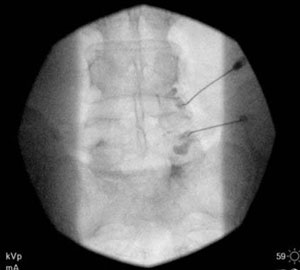How Do Spinal Injections Help?
Spinal injections serve two purposes:
- Diagnose or confirm the cause of pain
- Reduce or relieve inflammation and pain
Overview: Injection Procedure
A spinal injection, whether it is performed for diagnostic or therapeutic pain treatment, involves injecting a local anesthetic and/or corticosteroid into an area of the spine. In the case of an epidural injection, the medications are injected into the epidural space. The epidural space is between the protective membrane (dura mater) containing the spinal cord and the bony spinal canal. When a nerve root block is performed, the medication is injected into the nerve root sheath, a protective membrane (pia mater) covering each nerve root.
The procedure is performed using fluoroscopic guidance (real time X-ray). The doctor places the needle tip at the target area and confirms proper placement of the needle visually under fluoroscopy in different angles. He then injects a small amount of contrast (dye) to ensure correct spread. Next, a low volume of anesthetic / corticosteroid solution is injected.

One of three outcomes can be expected following a spinal injection: no pain relief; pain is relieved for a few hours, or days, and returns; or pain is relieved, long term.
- The outcome helps to identify the predominant pain generator, such as a cervical facet joint or lumbar nerve root.
- When pain is relieved, the patient benefits more fully from physical therapy.
- Chiropractic adjustments are more effective when guarding is reduced and range of motion is improved.
- Persistent symptoms may denote the need for additional or different pain treatment interventions.
- When surgery is recommended, the surgeon may depend on the results of precision diagnostic injections. Our practice retains a photographic image of each needle placement in patient records.
Pain Relief
Patients whose pain is adequately relieved or reduced may undergo additional injections at specific time periods. Although no two patients are identical, some patients become so attuned to their pain relief they know when to call to schedule their next injection procedure.
Our multidisciplinary pain practice is
interventional and comprehensive.

Some Conditions We Treat
- Herniated Disc
- Peripheral Neuralgia
- Post Laminectomy Syndrome
- Spinal Stenosis
- Spinal Spondylolisthesis
